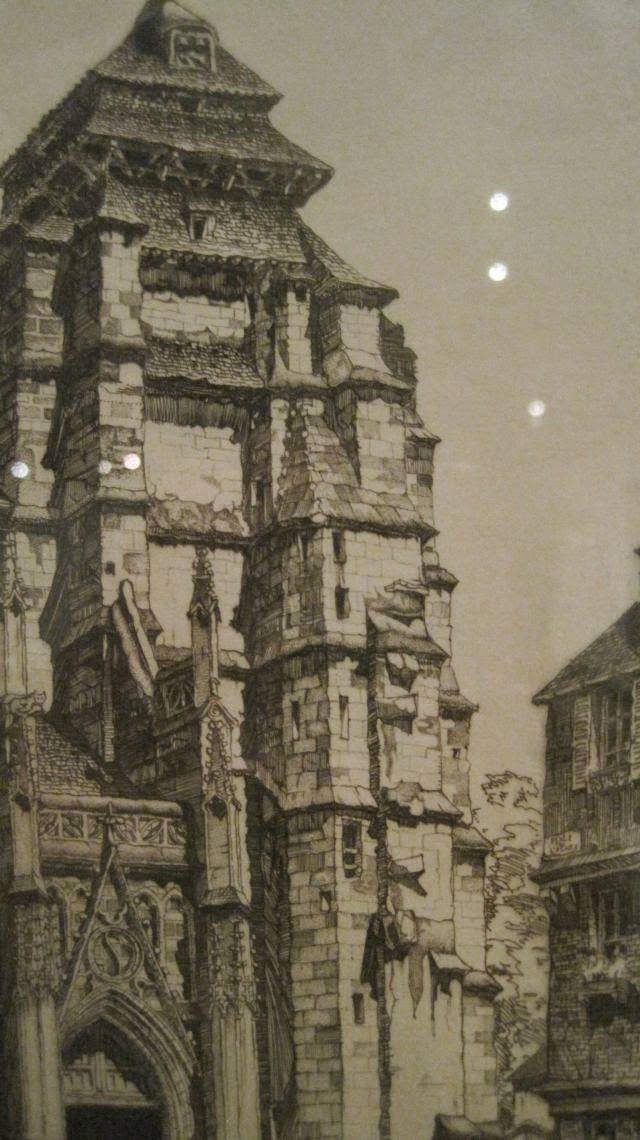This exhibit is features works that artists in our collection had given to one another as gifts. I came up with the idea when I was going through the works on paper collection for the first time. As I burrowed through the boxes of prints, I noticed that many had inscriptions on them running along the lines of "to so-and-so from so-and-so." I found these little tidbits compelling because they reminded me that these various artists knew one another personally, and were even friends in some cases. I started keeping a tally to see how many of these so-called "gift prints" we had, and as it turns out, there was enough to do a show.
The selection basically spans the first half of the 20th century. Most of the works were donated by Howard Cook and Barbara Latham, who gave their various holdings to the museum between the 1960s and the 1980s. They were among the most well-traveled artists in our collection, so they had artistic connections not only across the United States, but also Europe and Mexico. There are also several prints that belonged to Elmer Schooley and Gussie DuJardin, as well as a couple that B.J.O. Nordfeldt had given to Bertha E. Jacques, an important etcher based in Chicago.
What's been fun about working on this show is that it's not only allowed me to learn about the various social and artistic connections that our RMAC artists have had, but it's also given me an opportunity to show some great prints that haven't been on view for a long time. Several of the artists featured here didn't actually spend time in New Mexico, so they're not directly linked with the art scene here. They did know people like Cook and Latham, though, and highlighting those relationships emphasizes how interconnected New Mexico really is with the rest of the world.
As they say, it's all down to a matter of who you know.
Let's check out some of these artists. I took most of these pictures after the show was installed, so you'll have to put up with the gallery lights reflecting off the Plexi:
 |
| Rockwell Kent, Bringing Home the Christmas Tree, 1929, lithograph on paper. Roswell Museum and Art Center. |
Rockwell Kent was based in New York and Maine, for the most part, and is known for his solid, geometrically-inclined human figures that often exude a heroic quality. Christmas-tree hunting has never been more epic.
 |
| Victoria Hutson Huntley, Jack-in-the-Pulpit, 1930, lithograph on paper. Image courtesy of Roswell Museum and Art Center. |
Victoria Huntley studied lithography with George Miller, one of the few professional printers who worked exclusively for artists during the early 20th century. While this work is a botanical subject, she would initially gain recognition through a series of factory-related works, a subject that was considered most unusual for a woman at the time.
Speaking of George Miller, a lot of the artists featured in this show worked with him (including Howard Cook), not only because he was one of the only printers who accommodated artists (there were a few others), but for his hands-off approach to the creative side of printing. If he thought your aesthetic was hideous, he generally wouldn't let it on; he considered himself a craftsman rather than an artist.*
 |
| Louis Lozowick, Under the El (Hanover Square), 1929, lithograph on paper. Roswell Museum and Art Center. |
Louis Lozowick spent several years in Germany during the 1920s, where he encountered the work of the Russian Constructivists who had fled there after the Revolution. Lozowick's 1920s lithographs celebrate the promise of the city, and encapsulate the optimism society placed in technology during that period. I mean, just look at that beaming skyscraper!
 |
| John Taylor Arms, Eglise St. Michel, Pont l'Everque, 1927, etching. Roswell Museum and Art Center |
On the opposite extreme you have John Taylor Arms, who preferred to work on medieval subjects and evoke an earlier time. His etchings are known for their painstaking, almost neurotic attention to detail, and one cannot help but acknowledge his technical proficiency.
 |
| Detail of print to help you see all the lines that went into this piece. |
As I said before, most of the works come from the collection of Howard Cook and Barbara Latham, but not all. Here's a beauty that Carlsbad-based artist Roderick Mead gave to Elmer Schooley. This is from his Zodiac series, considered one of his most important printed works:
 |
| Roderick Mead, Zodiac Series: Sagittarius, late 1950s. Roswell Museum and Art Center. |
And finally, one of the etchings that B.J.O. Nordfeldt gave to Bertha E. Jacques, one of the founding members of the Chicago Society of Etchers.
 |
| B.J.O. Nordfeldt, Shopping in Florence, n.d., etching. Roswell Museum and Art Center. |
These prints looks marvelous in person, so if you're in the area, come check them out!
* For further reading on American lithography during the first half of the 20th century, I recommend this title: http://books.google.com/books/about/American_lithographers_1900_1960.html?id=hjlQAAAAMAAJ




Comments
Post a Comment
Questions? Comments? Speak your mind here.